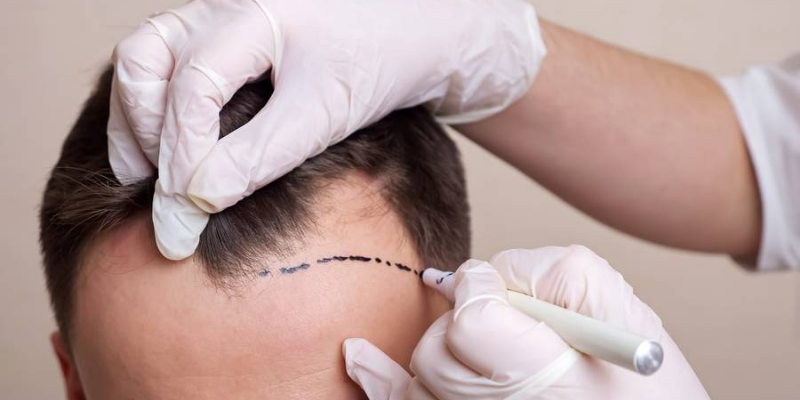Hair Transplant Procedure
Everyone has or will have to deal with hair loss at some point in their lives and need a hair transplant procedure. Even if there is no physical discomfort, the individual’s social life may suffer. In this case, it’s advisable to start treatment by considering long-term remedies. One of these treatments that ensures long-term results is hair transplant procedure. Each hair on the scalp grows for 2 to 6 years before falling out over time. An individual loses 50 to 150 hairs every day, on average. A fresh strand of hair grows in its place when a strand of hair falls off. A hair transplant is a natural technique that involves transplanting healthy hair to a bald area utilizing the same hair and hair follicle.
On the market, there are a range of oral products, many of which contain hormones. They can aid in the prevention of hair loss as well as the growth of new hair. Hair loss can also be treated using special conditioning shampoos, conditioners, and ampules that are rubbed into the scalp. Both of these therapy approaches, however, create long-term results, and the results may not be the same in every person because the effect varies. In this case, hair transplant procedure, which is the quickest and most permanent alternative, should be used. Hair implants and laser hair removal may also be preferring.
Who Should I Trust With My Hair Transplant?
The success of hair transplantation is governed by a number of factors. The type of hair transplant operation, the number of follicular and non-follicular piercings and grafts to be delivered by the team, the hair density to be provided by the team, the percentage of hair damaged during transplantation, the equipment used, the team’s training, and so on. The surgeons have collaborated on this project. As a result, a candidate should investigate the specifics of the above aspects before making a decision. A 10% root loss is considered normal after a successful hair transplant procedure.
A local anesthetic is used to numb the area and eliminate pain during the hair transplant surgical procedure. Because pain medication is administered after the procedure, there is no pain. Within the first 2-4 weeks, the transplanted hair normally falls off. New growth will begin in 3-4 months, and its length will increase by 1-2 mm per month. You can expect a fully natural result after 9-12 months. Starting about the fourth month, you will experience normal early hair loss, or “shedding,” before you notice hair growth. You should see optimum long-term results in 9-12 months.
What Is FUE Hair Transplantation, And How Does It Work?
It’s an excellent treatment for people who have hair loss or partial hair loss. It entails employing a micromotor with particular tips with a diameter of 0.8–1.1 mm to extract single, double, or triple follicular units from the scalp without leaving any incision marks or using stitches. Hair growth is achieved by transplanting follicular units (grafts) from the back and sides of the scalp to the desired spot. Both the donor and the recipient get a local anesthetic. It’s a simple, painless operation with no visible scars on the head.
The FUE method is the most advanced, modern, safe, and precise hair transplant procedure in the world. Anyone over the age of 22 who is in good health can get a hair transplant. The bald spot is filled with scalp transplanted from the rear of the head. The transplanted hair retains its color, texture, growth rate, and curl.
Hair Transplant Procedure: Is A Permanent Procedure?
Thanks to grafts taken from the genetically non-shedding part of the hair, the transplanted hair will last a lifetime. When performed by a trained physician and followed by proper postoperative care, hair transplant surgery can last a lifetime. Because the hair follicles are extracting from a zone that is resistant to hair loss, the scalp accepts the transplanted roots. As a result of the operation, the hair will regrow quite naturally, and the new hair will have the same characteristics as the existing hair in that area. Doctors prefer hair grafts from the back of the patient’s head (neck area). As a result, they keep this genetic feature even when transplanted into the patient’s recipient region.
People who have male or female pattern baldness are more prone to lose hair in the future. In the majority of cases, however, the problem can be rectified by performing a second or third hair transplant in the areas where new hair loss occurs. Because hair loss is on the rise, what may be accomplishing in a single session is physically limiting. Some individuals choose for multiple treatments to increase hair density. The hair transplanted is completely safe and will last a lifetime.
Hair Transplant Procedure: When Selecting A Hair Transplant Center, What Should You Look For?
Choosing the best hair transplantation institution, without a doubt, increases the chances of success even more. Given these improvements, it’s vital to think about a few things before selecting a hair transplant center. The most important thing to remember is that the hair transplant center should function as a clinic, with services and professionals selected accordingly. When looking for the best hair transplant center, this is the most critical factor to consider. Many hair transplant centers that claim to provide the best service with a variety of qualities that may emerge in the future on this topic actually endanger human life. Given these developments, hiring the best professionals in the best hair transplant clinic selection process is without a doubt the greatest decision.
After obtaining a full night’s sleep and being well resting, you should head to the hair transplant center the night before. When the front hairline is establishing too far ahead or too far behind, the naturalness of hair transplantation is affecting. Poor hair transplantation planning or a person’s donor area being insufficient can result in anterior hairline inaccuracy. Except for shortcomings in your donor area, there is no problem that limits natural hair transplantation without a remedy. If you make a careful decision, you might have natural-looking hair thanks to hair transplantation procedures performed by qualified professionals.
FUE Hair Transplant Procedure 101
The FUE hair transplant procedure is a great option for those needing to restore their hairline or cover bald patches. It offers an effective solution to hair loss and has minimal recovery time. After the procedure, it is important to follow all aftercare instructions as provided by your doctor. This includes avoiding strenuous activities, such as exercise and heavy lifting, for at least two weeks. Additionally, you will need to protect your scalp from the sun with a hat or sunscreen for several months and avoid extremely hot water when washing your hair. Taking these precautions will help ensure that you get the best possible results from your FUE hair transplant procedure.

Following these instructions is key in order to maintain healthy-looking, natural-looking results over time. During the healing process, many patients experience some scabbing or itching but this should subside within a few weeks as new hairs start coming in. Regular follow-up appointments with a hair transplant doctor or specialist may also be necessary to monitor healing. In some cases, multiple rounds of treatment may be necessary for optimal results; however, the results of a successful FUE hair transplant are permanent and can provide a natural-looking head of hair for many years.



